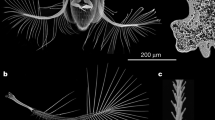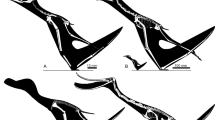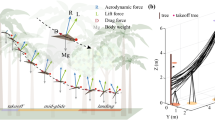Abstract
THE evolution of flight in insects triggered an unparalleled radiation and diversification such that flying insects comprise approximately two-thirds of all species1, yet a gap in the fossil record obscures the origins of wings and flight2. Among modern insects, stoneflies are morphologically primitive for several flight-related traits, which makes their locomotor behaviour and physiology of particular interest3. Here we show that Allocapnia vivipara stoneflies use a non-flying form of aerodynamic locomotion which may exemplify a precursor to flight. They raise their wings in response to wind, thereby sailing across water surfaces, but they are incapable of flapping. Sailing performance improves steadily with increasing wing size, and even the smallest wings significantly increase sailing velocity compared to wingless individuals. Performance during aerial gliding is less affected by wing size, which suggests that sailing is a more plausible setting for wing evolution. These results support the hypothesis that insect wings evolved from articulated gill plates of aquatic ancestors through an intermediate semi-aquatic stage4.
This is a preview of subscription content, access via your institution
Access options
Subscribe to this journal
Receive 51 print issues and online access
$199.00 per year
only $3.90 per issue
Buy this article
- Purchase on Springer Link
- Instant access to full article PDF
Prices may be subject to local taxes which are calculated during checkout
Similar content being viewed by others
References
Hammond, P. M. in Global Biodiversity (ed. Groombridge, B.) 17–39 (Chapman & Hall, London, 1992).
Kingsolver, J. G. & Koehl, M. A. R. Rev. Entomol. 39, 425–451 (1994).
Brodsky, A. K. The Evolution of Insect Flight (Oxford University Press, Oxford, 1994).
Marden, J. H. & Kramer, M. G. Science 266, 427–430 (1994).
Kinsolver, J. G. & Koehl, M. A. R. Evolution 39, 488–504 (1985).
Wootton, R. J. & Ellington, C. P. in Biomechanics in Evolution (ed. Rayner, J. M. V. & Wootton, R. J.) 99–112 (Cambridge University Press, Cambridge, 1991).
Kukalova-Peck, J. J. Morphol. 156, 53–126 (1978).
Kukalova-Peck, J. in The Insects of Australia 2nd edn (ed. Naumann, I. D.) 141–179 (Melbourne University Press, Melbourne, 1991).
Joosse, E. N. G. in Marine Insects (ed. Cheng, L.) 151–186 (North-Holland, Amsterdam, 1976).
Douglas, M. M. Science 211, 84–86 (1981).
Wigglesworth, V. B. Proc. R. Entomol. Soc., Lond. 28, 23–32 (1963).
Wootton, R. J. Antenna 10, 82–86 (1986).
Author information
Authors and Affiliations
Rights and permissions
About this article
Cite this article
Marden, J., Kramer, M. Locomotor performance of insects with rudimentary wings. Nature 377, 332–334 (1995). https://doi.org/10.1038/377332a0
Received:
Accepted:
Issue Date:
DOI: https://doi.org/10.1038/377332a0
Comments
By submitting a comment you agree to abide by our Terms and Community Guidelines. If you find something abusive or that does not comply with our terms or guidelines please flag it as inappropriate.



